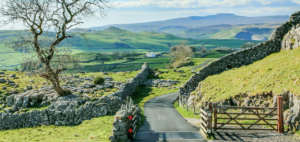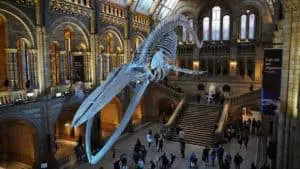The Irish Influence on American Folk Music: Exploring the Transatlantic Odyssey of Celtic Melodies
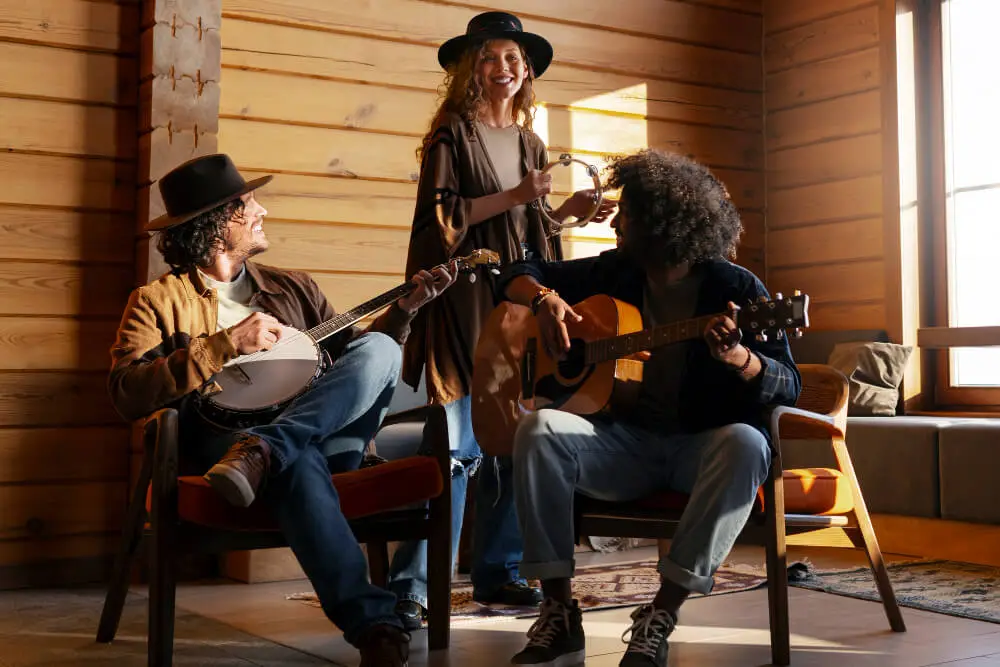
Updated On: April 23, 2024 by Yasmin Elwan
Our shared musical heritage is a tapestry of interwoven threads, with Irish traditional melodies playing a crucial role in the evolution of American folk music. The Irish influence on American folk music began in the 18th century, as waves of Irish immigrants brought with them the rhythms and tunes of their homeland. This transatlantic journey of Irish music intertwined with the cultural fabric of America, influencing the development of a distinct musical expression within the United States.

The influence of Irish music in America is most prominently felt in the Appalachian region, where the melding of Irish, Scots-Irish, and other cultural musical forms gave birth to what we now recognise as American folk. These melodies and instruments rooted in Ireland became a fundamental part of American music tradition. In urban settings, the Irish influence extended through live performances and recordings, further securing the place of Irish tunes in the annals of American music history.
Table of Contents
The Roots of Irish Music
Before delving into the more specific aspects of Irish music, it is imperative to recognise its rich heritage, deeply entwined with Ireland’s history and cultural identity. The essence of what we now cherish as traditional Irish music has evolved through a confluence of varied influences and a host of distinctive instruments that have given rise to early musical forms.
Influences and Origins
The origins of Irish music can be traced back to the Celtic period, marking a significant cultural imprint on Ireland. Drawing from a tapestry of European sources, with notable contributions from British and Scottish traditions, Irish music emerged as a distinctive genre. It’s believed that immigration during the Iron Age brought about an infusion of new sounds, particularly from areas such as Austria, Switzerland, France, and Spain, lending an Eastern flair to the evolving musical tradition.
Notable Instruments
Integral to the traditional sound are the unique instruments that shape its timbre. The harp, with its angelic resonance, is the cornerstone of Irish music, historically revered and symbolically represented on the Irish coat of arms. Fiddles and pipes, drawing similarities with their Scottish counterparts, offer a jubilant and poignant echo to the ensemble. Meanwhile, the bodhrán, a type of frame drum, lays the foundational rhythm, its beat as deep as the Irish heartbeat itself.
Early Irish Musical Forms
We observe that deeply rooted traditions sprung forth a variety of musical forms. Early iterations of dance music, such as jigs and reels, became the lifeblood of communal gatherings, while slow airs and ballads reflected the storytelling spirit of the Irish. These forms, steeped in our history, laid the groundwork for a transatlantic journey, profoundly influencing genres like American folk, with artists such as Dylan drawing from these ancestral wells.
Irish Music Emigration to America
We find it imperative to explore how Irish melodies traversed the ocean, interwove themselves into the fabric of American society, and became a staple in the American music scene.
The Great Migration
During the mid-nineteenth century, the devastating Great Potato Famine propelled over two million Irish to leave their homeland, seeking refuge across the Atlantic. High concentrations of these emigrants settled in cities like New York, Boston, and Chicago. With their luggage, they carried not just belongings but the rich tapestry of Irish traditional music, which included an array of instruments like the iconic fiddle.
Integration into American Culture
The Irish communities began to integrate, and with that, their music found a new rhythm in the American culture. The influence of Irish tunes became evident in various forms of American music, blending seamlessly with other cultural influences. The characteristic fiddle playing resonated through the burgeoning American folk and blues scenes, leaving an indelible mark that would be inherited by future generations of musicians upholding their Irish heritage.
Irish-Americans and the Music Scene Establishment
Noteworthy bands like Altan have been instrumental in championing Irish music abroad. Irish-Americans have strived to preserve the essence of their musical heritage, establishing themselves firmly within the music scene. They founded dedicated venues, festivals, and schools to ensure the tradition of Irish music continues to flourish on American soil, nurturing a unique cultural symphony that celebrates their dual identity.
Distinctive Features of Irish-American Music

The journey of Irish music across the Atlantic has embedded unique aspects into American folk music. This section explores how the roots of traditional Irish music have intertwined with American musical forms, resulting in a genre rich with distinctive styles and instruments.
Musical Characteristics
Irish-American music is characterised by its vibrant rhythms and emotive melodies. It retains key elements from traditional Irish music, like the fast-paced jigs and reels, coupled with lyrical ballads that often tell a story or convey a deep-seated emotion. Ornamentation, such as grace notes and vocal improvisation, is a hallmark of this genre. These embellishments add a layer of complexity and flair to the musical pieces, making them both captivating and challenging to perform.
Instrumentation
The instrumentation of Irish-American music is a unique blend of traditional and modern. Core traditional instruments include the fiddle, which is central to the sound, providing both melody and rhythm. The tin whistle and accordion inject the distinctive high-pitched tunes and bold, sustained harmonies characteristic of Irish melodies.
Meanwhile, instruments like the guitar and bouzouki have been adopted and adapted for this genre. The guitar provides robust rhythmic backing, while the bouzouki, originally a Greek instrument, has been embraced for its rich, resonant tones that complement the traditional Irish sound. The dobro, a type of resonator guitar, has become more prevalent, adding a sharp metallic twang that lends a new texture to the music.
Birth of American Folk Music
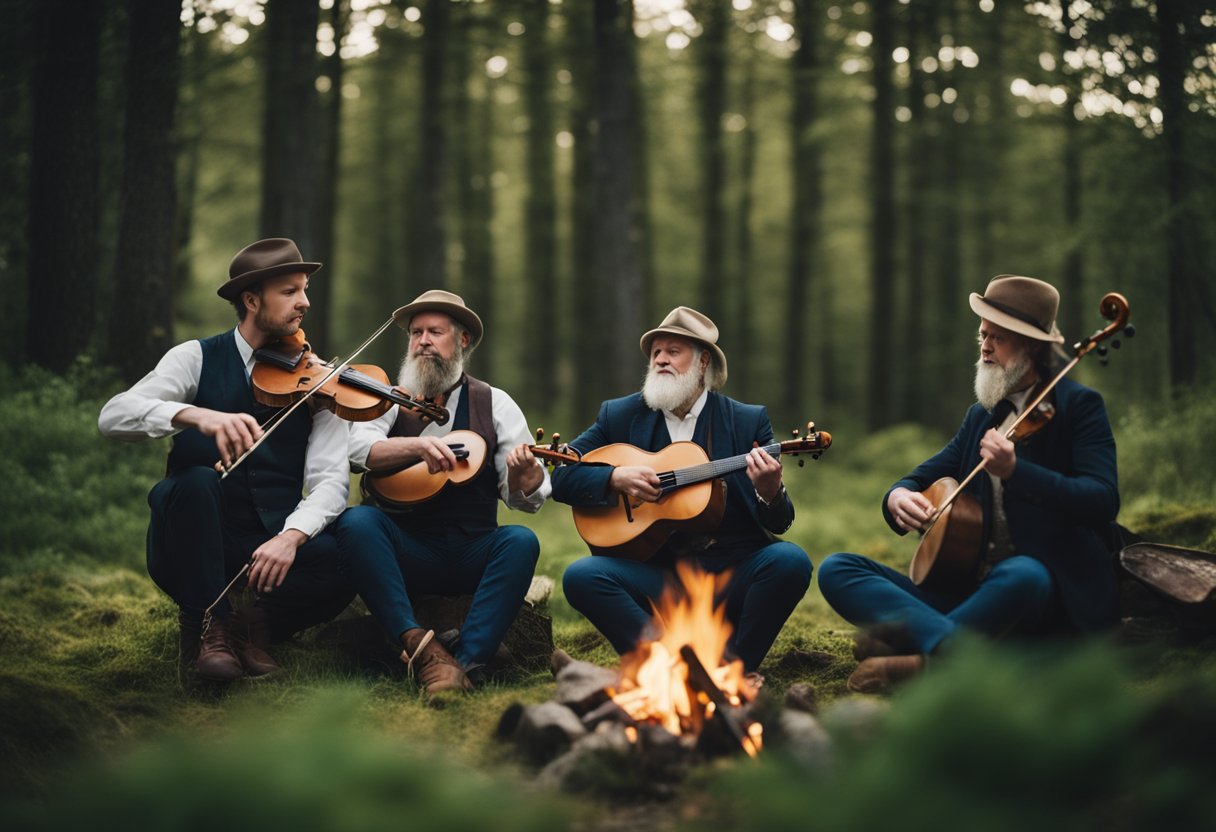
As we explore the intricacies of American folk music, we recognise its vibrant genesis. At the heart of this narrative is the profound influence of Irish melodies and rhythms woven into the very fabric of American genres.
Irish Influence on American Genres
The transatlantic journey of Irish music significantly shaped the emergence of various American music styles. Notably, bluegrass and country music have clear traces of Irish roots. The fiddle tunes and ballads carried over by Irish immigrants melded with American cultural expressions, resulting in a rich tapestry of musical forms. Celebrated artists like Doc Watson have upheld these traditions, highlighting the impact of Irish sounds.
Rise of Folk Music Icons
Amidst American music evolution, certain figures stand out for their definitive contributions. Woody Guthrie, with his poignant storytelling, paved the way for folk music as a means of sharing American stories. Following his path, artists such as Bob Dylan, particularly with his album “Bringing It All Back Home,” revolutionised folk and brought it to a wider audience. Through their music, these icons captured and solidified the culture and spirit of America’s diverse peoples.
Reverberation of Irish Tunes in Appalachia
As the Scots-Irish immigrants settled in the Appalachian Mountains, they brought with them their rich musical traditions, leaving a lasting mark on the soundscape of what would become known as Appalachian music.
Appalachian Musical Traditions
In the hollers and hills of Appalachia, traditional music has evolved as a unique blend, heavily influenced by the Scots-Irish heritage. Sounds of the fiddle—a central instrument in Irish music—melded with indigenous tunes and the banjo, an instrument with African origins, creating a new, distinct music genre. This cross-cultural fusion not only retained but amplified the storytelling aspect pivotal to Irish music. The music often reflects daily life, historical events, and personal experiences, becoming a vehicle for storytelling that is crucial to both the preservation and the perpetuation of Appalachian culture.
From Fiddles to Bluegrass
The musical journey from the traditional fiddle tunes to bluegrass can be traced through the evolution of Appalachian music. The incorporation of instruments like the fiddle and banjo into local music fostered the birth of bluegrass. Its development is credited to artists like Bill Monroe, who, inspired by his Scots-Irish roots, spearheaded a new style characterised by fast tempos and intricate, virtuosic playing. This new genre tapped into the veins of traditional Irish tunes yet was innovative and complex—eventually leading to influential artists like Bob Dylan, who would weave these threads into the tapestry of American folk music.
Urban Centres and Irish Tunes
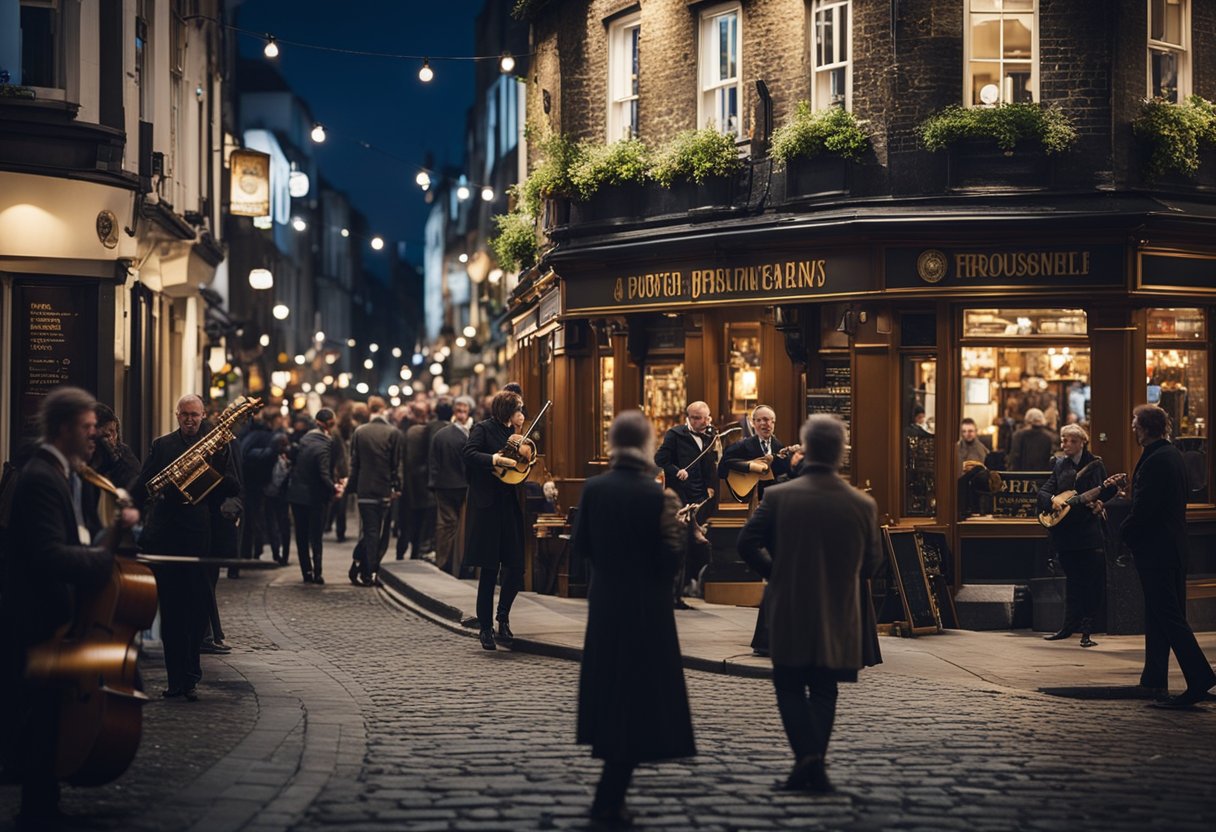
Irish music found a new rhythm in the urban centres of America, intertwining with the cultural tapestry of cities like New York, Boston, and Chicago. These metropolises became crucibles for Irish tunes, melded by the vibrant communities of Irish Americans.
New York’s Music Scene
New York has been a pulsing heart for Irish music within the USA. Amidst the city’s diverse soundscape, places like the famed neighbourhoods of the Bronx and Brooklyn became homes for Irish immigrants whose fiddles and tunes filled the taverns and parlours. Settings for gatherings where Irish traditional music thrived often doubled as spaces for cultural expressions, celebrating events like St. Patrick’s Day with authentic vigour.
Irish Music Hubs: Boston and Chicago
In Boston, a strong network of Irish Americans forged a thriving scene for Irish music. This city’s contribution to preserving and propagating the music of Ireland is unequivocal, with intimate pubs and concert halls reverberating with the sounds of groups like Altan and spontaneous sessions that attract both aficionados and new listeners alike.
Chicago’s Irish community has similarly championed this cultural inheritance. The city’s music scene is renowned for its festivals that showcase Irish music, offering a transatlantic journey of tunes that have been shaped by the experiences of the diaspora. The centrepiece of these is often traditional music, providing an experience that’s not just entertainment but also a connective thread to Irish heritage.
Folk Revivals and Irish Echoes
In tracing the transatlantic journey of Irish tunes, we must acknowledge the pivotal moments when Irish music found new life in America: the mid-20th-century revival and the ongoing contemporary resurgence.
Mid-20th Century Reawakening
The mid-20th century witnessed a significant reawakening of American interest in folk traditions, with Irish melodies and motifs receiving renewed attention. This period saw the revival of folksongs that encompassed the richness of Irish culture, cementing traditional music as a vital component of America’s musical heritage. Festivals celebrating this cultural exchange became common, weaving Irish threads into the tapestry of American folk music.
During this time, radio broadcasters like Fiona Ritchie played a vital role in introducing wider audiences to the nuances of traditional Irish songs. Her programme, Thistle & Shamrock, offered a weekly exploration of Celtic influences in contemporary and traditional music, reinforcing the transatlantic connection.
Contemporary Folk Resurgence
The contemporary resurgence of folk, spanning from the late 20th century to our current era, continues to highlight Irish influence. Bands such as Dropkick Murphys incorporate Irish melodies into their punk-infused anthems, showcasing the enduring appeal and adaptability of Irish music.
On the softer side of the spectrum, Sharon Shannon’s collaboration on “Galway Girl” emerged as a cultural phenomenon. This song, blending Irish folk with modern storytelling, is exemplary of how traditional Irish music continues to charm and resonate with contemporary audiences. Shannon herself, an acclaimed musician, has been instrumental in bringing traditional Irish tunes to the forefront of the global music scene.
Today, we find ourselves in an ever-evolving folk environment, where festivals and concerts serve as stages for both adherence to tradition and innovative fusion. This is a testament to the fluid nature of folk, which remains inclusive and yet distinctively Irish at its core.
Cultural Festivals and Live Performances

Irish influence on American folk music is vividly displayed through cultural festivals and live performances, showcasing a rich tapestry of Irish heritage and musical traditions.
St. Patrick’s Day Celebrations
St. Patrick’s Day serves as a pivotal moment each year when Irish music takes centre stage across the United States. On this day, cities burst to life with parades and performances that celebrate Ireland’s patron saint and cultural heritage. The sound of Irish traditional music resonates through the streets, and it’s common to hear the lively strumming of banjos and the cheerful melodies of tin whistles. Bands like Dropkick Murphys often partake in these festivities, infusing punk rock with Celtic melodies to entertain crowds eager to embrace Irish culture.
Year-Round Festivals and Concerts
Beyond St. Patrick’s Day, numerous year-round festivals and concerts honour and continue the tradition of Irish music. Festivals such as the Catskills Irish Arts Week and the Milwaukee Irish Fest attract thousands, offering music workshops, céilí dances, and performances by renowned Irish musicians. These events are more than just a gathering; they are a celebration of Irish heritage, providing an immersive experience where the sounds of jigs, reels, and hornpipes encourage everyone to dance and be merry. Through these vibrant expressions of music and dance, the spirit of Ireland is perpetuated far from its shores.
Irish Influence on American Folk Music Artists
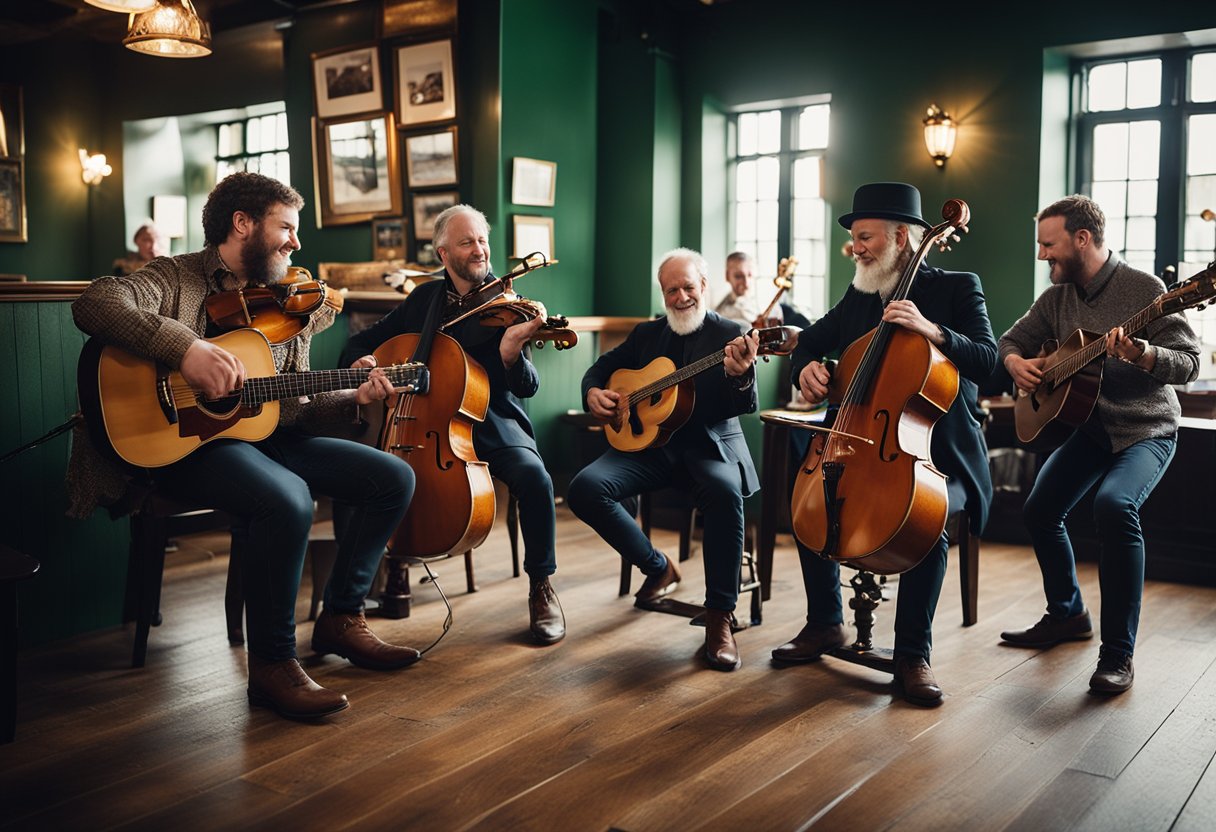
Irish music has travelled across the Atlantic and permeated modern music in various forms, inspiring a wealth of artists ranging from folk to pop genres. Modern musicians continue to weave Irish elements into their work, often leading to new and innovative music that still echoes its Irish origins.
Contemporary Adaptations
Artists like Paul Brady and Sharon Shannon have made significant contributions to modern music by infusing it with elements of traditional Irish songs. Brady’s work, characterised by his keen adaptability, bridges the gap between traditional Irish music and contemporary sensibilities. Shannon, known for her mastery of the accordion, has also pushed the boundaries of Irish music, integrating it seamlessly with modern genres. Their impact is evident in how they have shaped the Irish-American identity through music, influencing artists who seek to explore and celebrate their cultural heritage.
Cross-Genre Collaborations
Appalachian music, with its own rich history, has been particularly receptive to the influence of Irish tunes, sharing as it does many commonalities with Irish traditional music. Irish music’s journey into modern music has been marked by numerous collaborations where artists deftly combine genres. These collaborative efforts highlight the compatibility and enduring nature of Irish music and how its melodic and rhythmic structures can enhance and elevate various musical styles.
The Role of Recordings and Broadcasting

Recordings and broadcasting have played pivotal roles in perpetuating and evolving Irish folk music within American culture. These mediums have not only preserved traditional tunes but also facilitated their fusion with American genres, contributing to a vibrant transatlantic musical tapestry.
Historical Recordings
Historical recordings surface as a cornerstone in transmitting the essence of Irish music across the Atlantic. Notable figures and groups such as Eileen Ivers and Altan have been instrumental in archiving traditional melodies through their albums. These recordings serve as touchstones for both musicians and enthusiasts seeking to explore the intricacies of Irish music and its influence on American folk traditions.
Radio and Online Influence
In the digital age, radio and online platforms have exponentially magnified the accessibility and impact of Irish music. Broadcasting pioneers like Fiona Ritchie, through her radio show, have brought the nuanced textures of Irish music to a broader audience. Further, in a marriage of old and new, bands like Dropkick Murphys integrate the raw energy of Irish tunes with contemporary American sounds, spreading their influence via digital channels—thus reflecting the resilience and adaptability of Irish culture in the modern soundscape.
Preserving and Teaching Irish Music

In our quest to keep the rich tapestry of Irish music alive, educational programs and mentorship play a pivotal role. This not only aids in retaining musical traditions but also in fostering new generations of musicians who are steeped in Ireland’s cultural heritage.
Educational Programs
Educational initiatives are critical for the teaching and learning of Irish music. We find numerous courses that integrate bouzouki, sean-nós singing, and other traditional instruments and styles into their curricula. For instance, music schools might offer specific workshops on the history of songs like “Rose Connolly,” facilitating a deeper understanding and appreciation of the music’s roots and variations. Some programmes may also highlight successful artists such as Eileen Ivers, whose work embodies the fusion of Irish musical traditions with other genres, serving as educational case studies for students.
Mentorship and Musical Learning
The passing down of knowledge from one musician to another is a time-honoured tradition in Irish music. Mentorship plays a vital part in preserving cultural heritage, with experienced musicians often taking young protégés under their wing, imparting skills in both formal settings and informal gatherings like pub ceilis. These interactions aren’t just about transferring knowledge; they’re also about instilling a sense of cultural pride and continuity within learners. Through mentorship, the nuances of traditional Irish music, from the lilt of a jig to the emotive grace of a slow air, are kept alive and vibrant for future generations to cherish.
Frequently Asked Questions
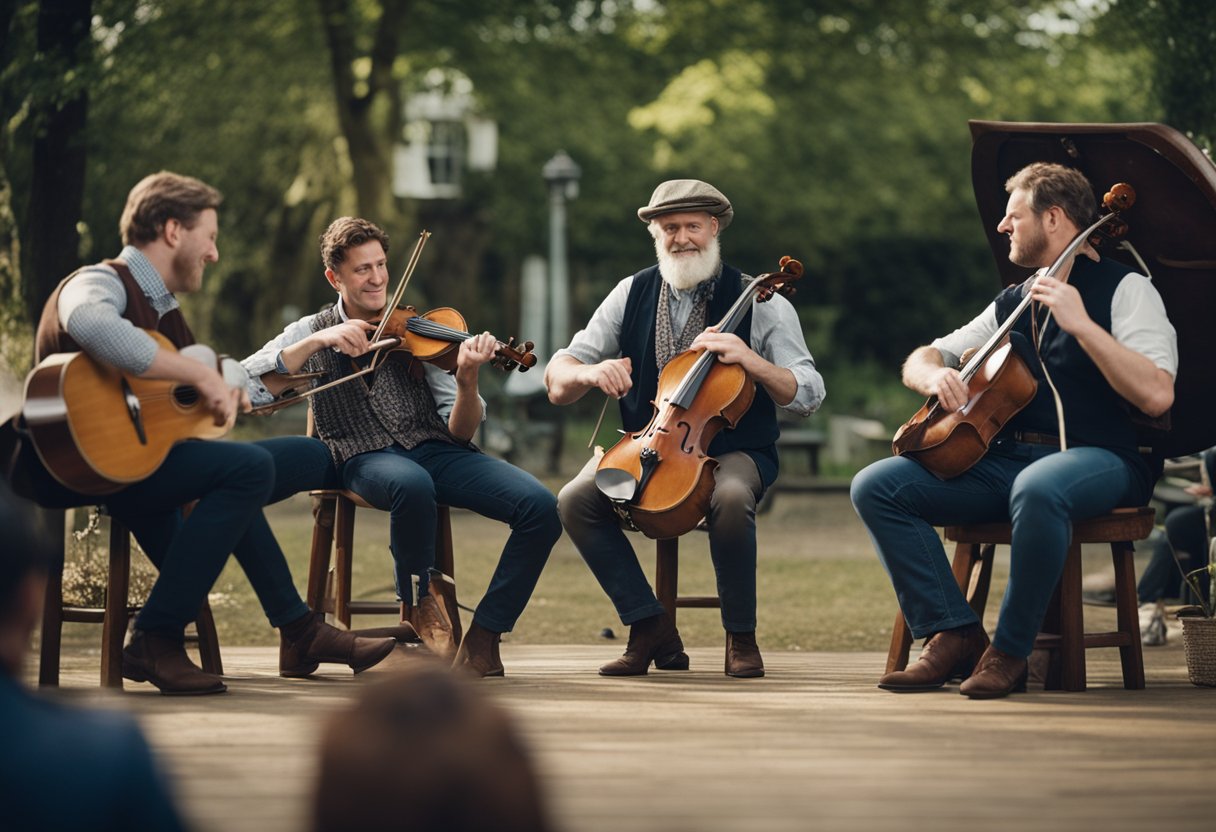
In this section, we’re addressing some of the most common inquiries regarding the interplay between Irish and American folk music, shedding light on how these two traditions have intertwined over the centuries.
In what ways did Irish melodies integrate into American folk tunes?
Irish melodies often mingled with American folk tunes through the process of cultural exchange, particularly as Irish immigrants brought their music to the New World. The fluid nature of folk music allowed Irish tunes to blend with other cultural influences, creating hybrid compositions.
What elements of Irish traditional music can be detected in American folk genres?
The rhythmic, melodic, and lyrical elements of Irish traditional music have left a clear imprint on American folk. Specific modes and the use of ornamentation in melodies are distinguishing features that have permeated American folk genres.
How significant was the role of Irish immigrants in shaping American folk music?
The contribution of Irish immigrants to American folk music was substantial. Their music provided a foundational repertoire and influenced emerging styles, such as country and bluegrass, which have become quintessential elements of the American musical landscape.
Can parallels between Irish folk music and American bluegrass styles be traced?
Yes, parallels between Irish folk music and American bluegrass styles can certainly be traced. Both genres share a common emphasis on stringed instruments and feature fast, intricate melodies.
What are some examples of Irish instruments that have influenced American folk music?
Noteworthy Irish instruments that have influenced American folk music include the fiddle, which is central to both traditions and the tenor banjo, which has been enthusiastically adopted and adapted by American folk musicians.
How have Irish folk music techniques been adapted in the context of American music traditions?
Techniques inherent to Irish folk music, such as the use of drones and the practice of group playing in sessions, have been adapted in the context of American music to suit local tastes, social gatherings, and performance practices.





